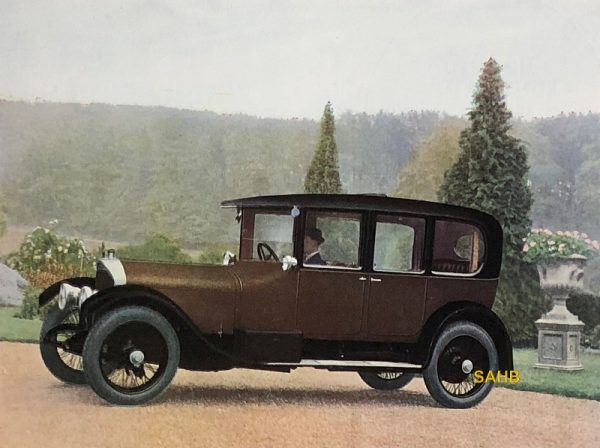
The Napier before World War I was very much an Edwardian motor car, with separate cylinders and the awkward look of its forward-mounted radiator. All that changed after the war. Mechanically, the 40/50 introduced in 1919 showed the influence of Napier’s wartime aero engine experience. The new car was designed by A. J. Rowledge; he had been responsible for the wartime W12 Lion aero engine, and a number of elements of the Napier 40/50 engine show clear influence from the design of the Lion – in particular the aluminium block and overhead camshafts. (Rowledge left Napier for Rolls-Royce in 1921 and was responsible for the design of several of their aero engines, including the Condor III and the Kestrel, and for developing the Buzzard into the Rolls-Royce R racing engine, used with great success in the 1929 and 1931 Schneider Trophy races.)
The six-cylinder Napier 40/50 engine had a capacity of 6,178 cc from a bore and stroke of 101.6 mm × 127 mm or 4 inches x 5 inches; significant weight-saving was achieved by using a single cast aluminium block with shrunk-in steel liners. An overhead camshaft was driven by a vertical shaft with worm gears at top and bottom. The valves were operated by rockers with the camshaft sitting between the fulcrum and the valves, thus allowing small cams with gentle slopes, for quietness in operation. The aluminium cylinder head was detachable for easy access to the valves for decarbonisation. The pressure-fed crankshaft was supported in seven main bearings. Ignition was by dual magneto and coil with dual plugs, and induction was by a single Napier-SU Carburettor.
Such a strongly built engine could expected to run up to 3,000 rpm and produce an easy 120 bhp, but its single carburettor restricted induction – possibly a deliberate ploy to achieve smooth operation. Maximum engine speed was only 2,000 rpm, for an output of 82 bhp, perfectly adequate for a luxury car on the roads of the time.
Coachwork of the 40/50 was by Cunard, by then a subsidiary. The car was expensive, with a chassis price in 1923 of £1,500, about the same as a Rolls-Royce Silver Ghost, and sales were slow. Sources differ on the number of cars built, perhaps as few as 190 or as many as 300, and in 1924 the last car was sold; Napier then concentrated entirely on the manufacture of aero engines until their abortive attempt to re-enter the car business by bidding for Bentley in 1931.
Image courtesy of The Richard Roberts Archive: www.richardrobertsarchive.org.uk







Leave a Comment